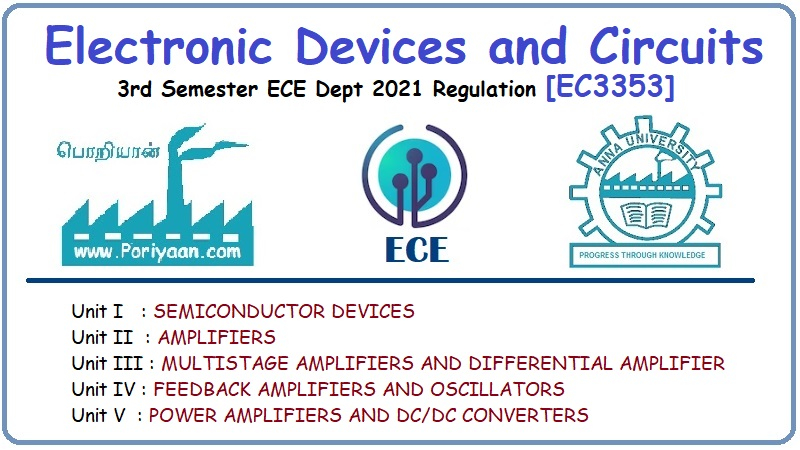Electronic Devices and Circuits: Unit I: Semiconductor Devices
Operation on NPN and PNP Transistor
Semiconductor Devices
As the base is lightly doped with P-type material the number of holes in the base region is very small and hence the number of electrons that combine with holes in the p-type base region is also very small.
OPERATION ON NPN TRANSISTOR AND PNP TRANSISTOR
NPN Transistor
Operation
As shown in Fig.1.35, the forward bias applied to the emitter base junction of an NPN transistor causes a lot of electrons from the emitter region to crossover to the base region.
As
the base is lightly doped with P-type material the number of holes in the base
region is very small and hence the number of electrons that combine with holes
in the p-type base region is also very small. Hence few electrons combine with
holes to constitute a base current IB. The remaining electrons (more
than 95%) crossover into the collector region to constitute collector current IC.
Thus the base and collector current summed up gives the emitter current i.e., IE
= - (IC + IB).
In
the external circuit of the NPN bipolar junction transistor, the magnitudes of
the emitter current IE, the base current I, and the collector current Ic are
related by IE = (IC + IB).

PNP Transistor
Operation
As
shown in Fig.1.36, the forward bias applied to the emitter base junction of PNP
transistor causes a lot of holes from the emitter region to crossover to the
base region as the base is lightly doped with N type material. The number of
electrons in the base region is very small and hence the number of holes
combined with electrons in the N-type base region is also very small. Hence a
few holes combined with electrons to constitute a base current Ig. The
remaining holes (more than 95%) cross over into the collector region to
constitute a collector current IC. IE = - (IC +
IB).
In the external circuit of the PNP bipolar junction transistor the magnitude of the emitter current IE, the base current IB and the collector current IC are related by
IE = IC + IB ................(1)

This
equation gives the fundamental relationship between the currents in a bipolar
transistor circuit. Also this fundamental equation shows that there are current
amplification factors α and β in common base transistor configuration and
common emitter transistor configuration respectively for the static (dc) currents
and for small changes in the currents.
Large-Signal Current Gain (α)
The
large signal current gain of a common base transistor is defined as the ratio
of the negative of the collector-current increment to the emitter-current
change from cutoff (IE = 0) to IE i.e.,

Where
ICBO (or ICO) is the reverse saturation current flowing
through the reverse biased collector-base junction, i.e., the collector to base
leakage current with emitter open. As the magnitude of ICBO is
negligible when compared to IE, the above expression can be written
as

Since
IC and IE are flowing in opposite directions, a is always
positive. Typical value of α ranges from 0.90 to 0.995. Also a is not a
constant but varies with IE, VCB, and temperature.
Electronic Devices and Circuits: Unit I: Semiconductor Devices : Tag: : Semiconductor Devices - Operation on NPN and PNP Transistor
Related Topics
Related Subjects
Electronic Devices and Circuits
EC3353 - EDC - 3rd Semester - ECE Dept - 2021 Regulation | 3rd Semester ECE Dept 2021 Regulation
